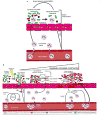Human neutrophils and oral microbiota: a constant tug-of-war between a harmonious and a discordant coexistence
- PMID: 27558341
- PMCID: PMC5353849
- DOI: 10.1111/imr.12451
Human neutrophils and oral microbiota: a constant tug-of-war between a harmonious and a discordant coexistence
Abstract
Neutrophils are a major component of the innate host response, and the outcome of the interaction between the oral microbiota and neutrophils is a key determinant of oral health status. The composition of the oral microbiome is very complex and different in health and disease. Neutrophils are constantly recruited to the oral cavity, and their protective role is highlighted in cases where their number or functional responses are impeded, resulting in different forms of periodontal disease. Periodontitis, one of the more severe and irreversible forms of periodontal disease, is a microbial-induced chronic inflammatory disease that affects the gingival tissues supporting the tooth. This chronic inflammatory disease is the result of a shift of the oral bacterial symbiotic community to a dysbiotic more complex community. Chronic inflammatory infectious diseases such as periodontitis can occur because the pathogens are able to evade or disable the innate immune system. In this review, we discuss how human neutrophils interact with both the symbiotic and the dysbiotic oral community; an understanding of which is essential to increase our knowledge of the periodontal disease process.
Keywords: neutrophils; periodontitis; symbiotic and dysbiotic oral community.
© 2016 John Wiley & Sons A/S. Published by John Wiley & Sons Ltd.
Conflict of interest statement
Figures


Similar articles
-
Neutrophil Interaction with Emerging Oral Pathogens: A Novel View of the Disease Paradigm.Adv Exp Med Biol. 2019;1197:165-178. doi: 10.1007/978-3-030-28524-1_12. Adv Exp Med Biol. 2019. PMID: 31732941 Review.
-
The oral microbiome and the immunobiology of periodontal disease and caries.Immunol Lett. 2014 Dec;162(2 Pt A):22-38. doi: 10.1016/j.imlet.2014.08.017. Epub 2014 Nov 8. Immunol Lett. 2014. PMID: 25447398 Free PMC article. Review.
-
Innate Phagocyte Polarization in the Oral Cavity.Front Immunol. 2022 Jan 6;12:768479. doi: 10.3389/fimmu.2021.768479. eCollection 2021. Front Immunol. 2022. PMID: 35069541 Free PMC article. Review.
-
The Oral Host-Microbial Interactome: An Ecological Chronometer of Health?Trends Microbiol. 2021 Jun;29(6):551-561. doi: 10.1016/j.tim.2020.11.004. Epub 2020 Dec 2. Trends Microbiol. 2021. PMID: 33279381 Review.
-
Loss of Neutrophil Homing to the Periodontal Tissues Modulates the Composition and Disease Potential of the Oral Microbiota.Infect Immun. 2021 Nov 16;89(12):e0030921. doi: 10.1128/IAI.00309-21. Epub 2021 Sep 7. Infect Immun. 2021. PMID: 34491788 Free PMC article.
Cited by
-
Interactions Between Neutrophils and Periodontal Pathogens in Late-Onset Periodontitis.Front Cell Infect Microbiol. 2021 Mar 12;11:627328. doi: 10.3389/fcimb.2021.627328. eCollection 2021. Front Cell Infect Microbiol. 2021. PMID: 33777839 Free PMC article. Review.
-
Extracellular Vesicle Subproteome Differences among Filifactor alocis Clinical Isolates.Microorganisms. 2022 Sep 13;10(9):1826. doi: 10.3390/microorganisms10091826. Microorganisms. 2022. PMID: 36144428 Free PMC article.
-
The Roles of FOXO1 in Periodontal Homeostasis and Disease.J Immunol Res. 2021 Mar 30;2021:5557095. doi: 10.1155/2021/5557095. eCollection 2021. J Immunol Res. 2021. PMID: 33860060 Free PMC article. Review.
-
Increased mucosal neutrophil survival is associated with altered microbiota in HIV infection.PLoS Pathog. 2019 Apr 11;15(4):e1007672. doi: 10.1371/journal.ppat.1007672. eCollection 2019 Apr. PLoS Pathog. 2019. PMID: 30973942 Free PMC article.
-
Neutrophils, from cradle to grave and beyond.Immunol Rev. 2016 Sep;273(1):5-10. doi: 10.1111/imr.12463. Immunol Rev. 2016. PMID: 27558324 Free PMC article. No abstract available.
References
-
- Meyle J, Chapple I. Molecular aspects of the pathogenesis of periodontitis. Periodontol. 2015;200069:7–17. - PubMed
Publication types
MeSH terms
Grants and funding
LinkOut - more resources
Full Text Sources
Other Literature Sources
Medical

